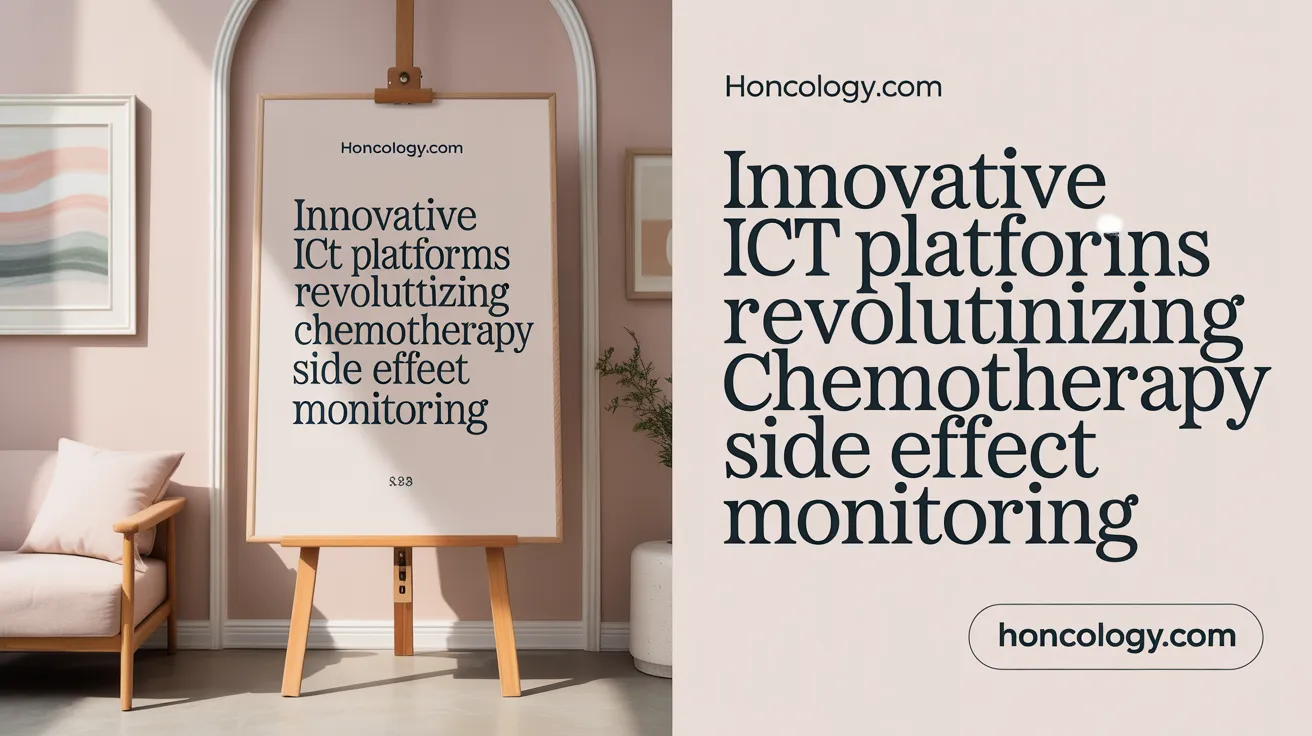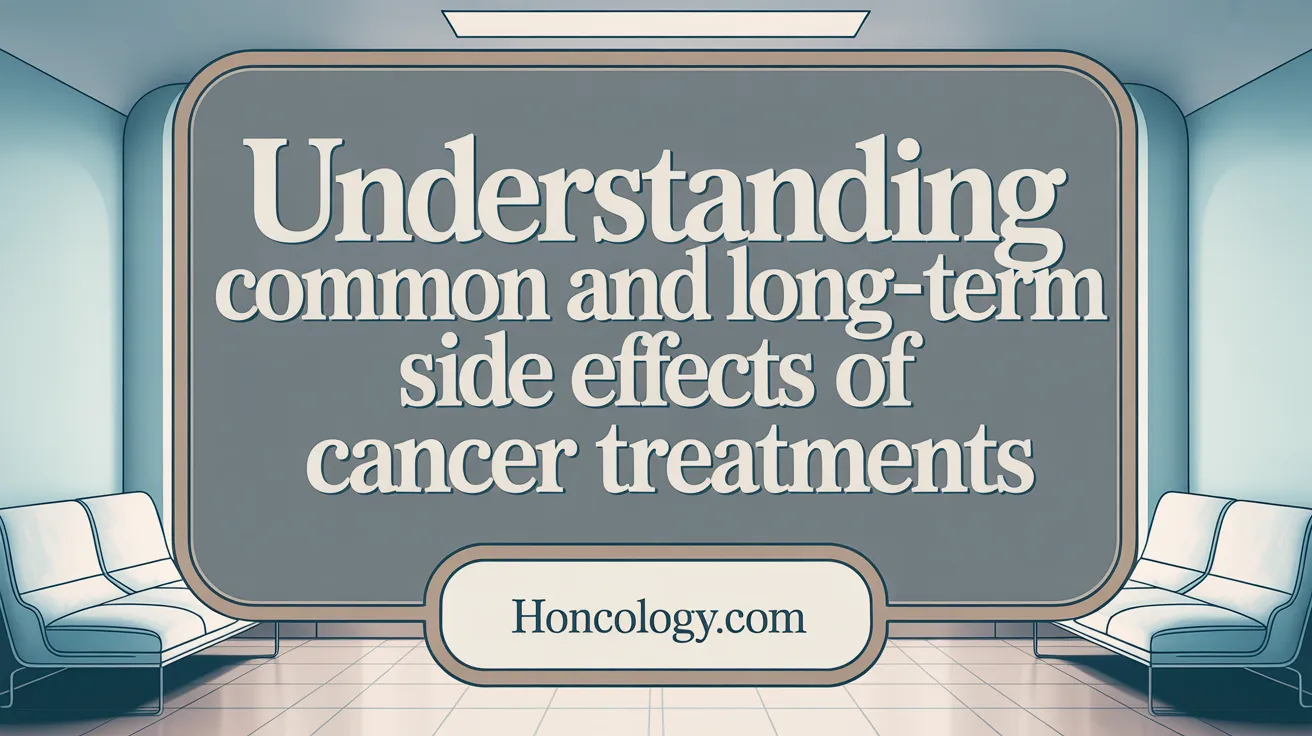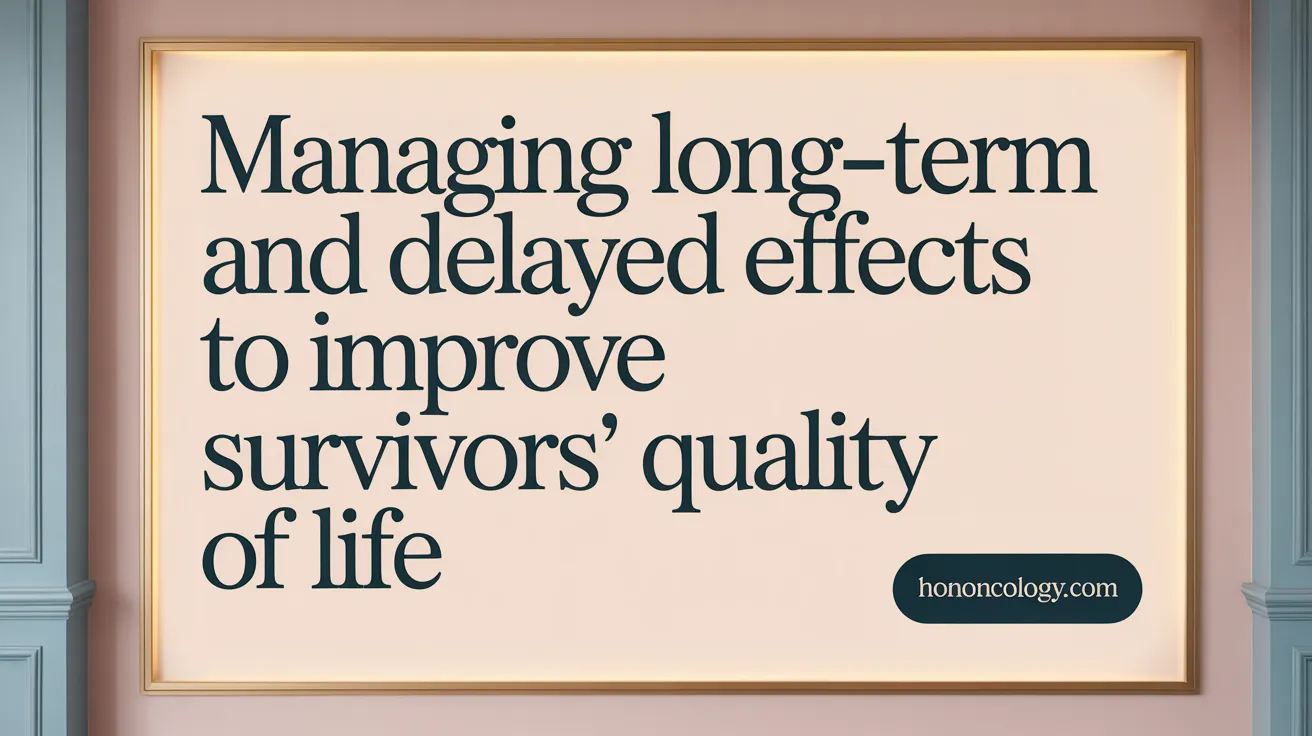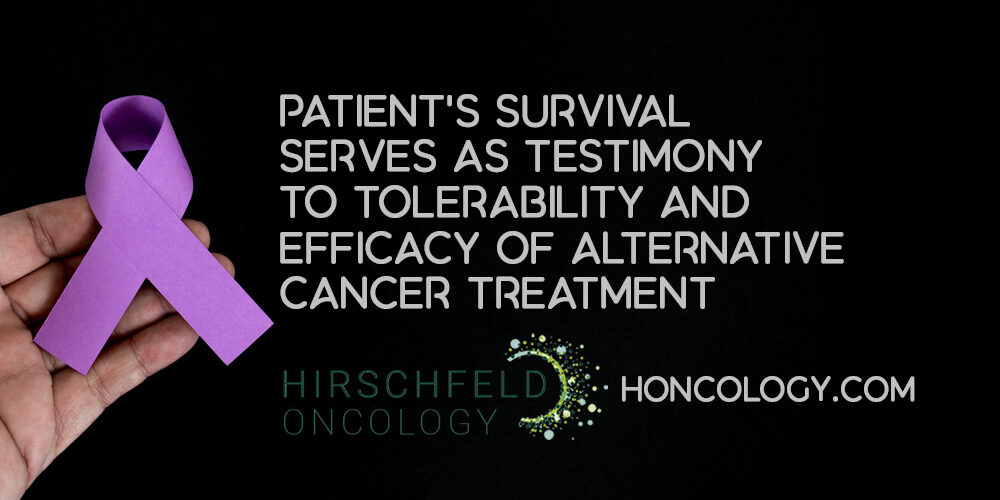Introduction to Advancements in Cancer Side Effect Management
Overview of cancer treatment side effects
Cancer treatments such as chemotherapy, radiation, immunotherapy, and targeted therapies aim to destroy cancer cells but often affect healthy tissues. Common side effects encompass fatigue, nausea, hair loss, changes in blood counts, cognitive challenges known as "chemo brain," neuropathy, and digestive issues like diarrhea or constipation. These side effects can manifest immediately during treatment or emerge as long-term complications, impacting physical, emotional, and cognitive health.
Importance of side effect management for patient quality of life and treatment adherence
Effective management of these side effects is crucial to maintain patient quality of life, reduce psychological distress, and sustain treatment adherence. Unmanaged side effects can lead to treatment interruptions, decreased effectiveness, and increased hospital visits. Innovative approaches—including digital monitoring platforms, personalized medications, patient education, and supportive care interventions—facilitate early symptom detection and timely management, improving overall outcomes and patient satisfaction during cancer therapy.
Smart Cancer Care: Harnessing Technology for Early Symptom Detection and Management

ICT-based platforms for chemotherapy side effect monitoring
The Smart Cancer Care platform is an innovative information and communication technology (ICT)-based system designed to help manage side effects from chemotherapy. This platform consists of two main components: a patient-facing app for chemotherapy side effects and a medical staff dashboard. It focuses on monitoring 32 chemotherapy symptoms, aiming to guide patients and healthcare providers through appropriate management steps depending on severity. These steps are divided into three stages: preventive management guidelines, self-care guidelines for chemotherapy, and medical consultation for chemotherapy.
Patient-reported outcomes and real-time symptom tracking
A critical feature of Smart Cancer Care is its use of patient-reported outcomes (PRO) in cancer care. Patients regularly self-report their symptoms using the app, allowing real-time tracking and improved accuracy in symptom detection. This immediate exchange enables early intervention for chemotherapy side effects, potentially reducing emergency room visits and hospitalizations by addressing side effects promptly. Real-time symptom data also enhances enhanced patient-healthcare communication, particularly valuable when patients are spending more time at home in outpatient settings.
Pilot study results on platform feasibility and satisfaction
A pilot study tested Smart Cancer Care with 30 patients undergoing chemotherapy and 24 medical staff members. The results showed high feasibility of Smart Cancer Care platform and helpfulness of Smart Cancer Care for patients and helpfulness of Smart Cancer Care for medical staff for both groups. Patients rated the platform’s helpfulness about 4.80 out of 5, while medical staff gave a score of 4.89 out of 5. Both were satisfied with the ease of use and the improved symptom management and communication offered by the system.
Potential for expanded use beyond chemotherapy
While developed primarily for chemotherapy side effect management, the Smart Cancer Care platform was designed with adaptability in mind. It can potentially be expanded to expand symptom monitoring beyond chemotherapy and manage symptoms related to other cancer treatments. By leveraging integrating ICT tools in cancer care and integrating patient-reported data, this platform represents a scalable model that may enhance symptom monitoring and improve patient quality of life with ICT across various oncology care settings.
Comprehensive Understanding of Cancer Treatment Side Effects

What Are the Common Side Effects Across Cancer Treatments?
Cancer treatments, including chemotherapy, radiation, immunotherapy, hormone therapy, and targeted therapies, can cause a range of side effects affecting various body systems. Commonly experienced effects include:
- Fatigue: A frequent symptom across all treatments, often impacting quality of life significantly.
- Gastrointestinal Issues: Nausea, vomiting, diarrhea, constipation, loss of appetite, and oral problems such as mouth sores or dry mouth (Managing cancer-related side effects, Managing Cancer Side Effects with Nutrition).
- Blood-related Effects: Low blood counts such as anemia, neutropenia (low white blood cells), and thrombocytopenia (low platelets), resulting in infections, bruising, or bleeding (Managing cancer-related blood problems).
- Skin and Hair Changes: Hair loss, dryness, rash, and nail alterations (Managing Side Effects of Cancer Treatment).
- Cognitive Changes: Often referred to as "chemo brain," including memory and concentration problems.
- Neuropathy: Numbness, tingling, or pain mainly from chemotherapy (Chemotherapy-Induced Peripheral Neuropathy (CIPN)).
- Mental Health Impacts: Anxiety, depression, loneliness, and distress (Mental health during cancer).
- Sexual and Fertility Issues: Treatment-specific effects on sexual function and reproductive health (Fertility preservation and cancer.
What Are Long-Term and Delayed Side Effects?
Some side effects can persist or emerge months to years after treatment ends:
- Cancer-Related Fatigue (CRF): A chronic condition affecting physical, emotional, and cognitive health (Cancer-related fatigue overview.
- Chemotherapy-Induced Peripheral Neuropathy (CIPN): Long-lasting nerve pain and sensory symptoms (CIPN management strategies.
- Cognitive Impairment: Ongoing memory and processing speed difficulties (Chemotherapy-related cognitive impairment (CRCI).
- Fertility Challenges: Potential infertility requiring prior preservation options (Fertility preservation in cancer treatment.
- Cardiotoxicity and Pulmonary Toxicity: Damage to heart and lungs may appear later, especially after specific chemotherapy or radiation (Cardiotoxicity in anticancer therapy.
- Secondary Cancers: Increased risk of new cancers years after initial treatment (Secondary malignancies post treatment.
- Emotional Distress: Long-term psychological effects needing supportive care (Emotional distress in cancer survivors.
What Strategies Are Recommended for Symptom Management?
Mitigation and management focus on improving quality of life and treatment adherence:
- Symptom Monitoring: Using patient-reported outcomes (PRO) and digital platforms like the Smart Cancer Care platform for early detection and intervention.
- Medication and Supportive Care: Antiemetics for nausea, pain management protocols, and treatments for blood count support such as growth factors (Advances in chemotherapy side effect management).
- Lifestyle and Nutrition: Balanced diet, hydration, physical activity, and rest scheduled to reduce fatigue (Managing Cancer Side Effects with Nutrition.
- Patient Education: Proactive communication about side effects and preventive strategies (Effective side effect management in breast cancer).
- Psychological Support: Counseling, cognitive-behavioral therapy, mindfulness, and peer support (Mental health and cancer care.
- Specialized Interventions: Fertility preservation, scalp cooling for hair loss, and neuropathy management techniques (Supportive care innovations).
Continuous advances in technology, including ICT-based chemotherapy symptom management tools and emerging therapies such as nanotech-enhanced chemotherapy drugs, support personalized symptom management to optimize patient safety and wellbeing.
Innovative Pharmacologic and Supportive Interventions in Side Effect Management
Approval and Use of Newer Antiemetics
Modern cancer care has seen significant improvements in managing chemotherapy-induced nausea and vomiting (CINV) management through the introduction of 5-HT3 antagonists like ondansetron and palonosetron. These drugs effectively prevent and reduce nausea, improving patient comfort during chemotherapy. Additionally, Neurokinin-1 (NK-1) receptor antagonists have been approved to provide sustained antiemetic effects, helping patients better tolerate their treatments.
Biosimilar Drugs and Novel Agents
Biosimilar drugs such as filgrastim in neutropenia management have increased accessibility to treatments for neutropenia by offering cost-effective alternatives to original biologics. Another novel agent, trilaciclib for myelosuppression, recently approved for chemotherapy-induced myelosuppression, shows promising results in reducing severe neutropenia, highlighting advances in protecting blood cell counts during therapy.
Emerging Research on Photobiomodulation and Cannabinoids
Innovative supportive care research explores photobiomodulation for oral mucositis, or light therapy, as a treatment for oral mucositis, a painful side effect of chemotherapy and radiation. Devices have been developed to treat large areas of the mouth to alleviate symptoms. Cannabinoids like nabilone for chemotherapy nausea are licensed for chemotherapy-related nausea, and cannabidiol (CBD) is being studied for potential protective effects against mucosal damage, though more large-scale trials are needed.
Advances in Neuropathy Prevention Techniques
To address chemotherapy-induced peripheral neuropathy, cooling methods such as freezing gloves and socks help reduce nerve damage caused by platinum-based therapies, with varying success. Research continues on radioprotective agents and Tempol and molecules that scavenge free radicals to mitigate neuropathy and radiation dermatitis, aiming to improve patient safety and quality of life.
Challenges of Insurance Coverage and Accessibility
Despite these therapeutic advances, challenges remain in insurance coverage, especially for oral supportive medications. Often, intravenous drugs receive preferential coverage, creating barriers for patients in accessing convenient oral treatments. Advocacy efforts are underway to align insurance policies with modern supportive care practices, empowering patients to manage side effects effectively at home, as detailed in advances in chemotherapy side effect management.
Patient Education and Digital Tools Empowering Side Effect Management
Why is proactive communication about side effects important?
Effective management of side effects starts with patients receiving timely and comprehensive information before or soon after treatment begins. Many patients report receiving inadequate information, often only after experiencing side effects, which can lead to increased anxiety and even treatment interruption. Proactive communication helps patients anticipate symptoms, understand preventive strategies, and feel more empowered to manage their care (Effective side effect management in breast cancer, management of breast cancer treatment side effects.
How do apps and web platforms support symptom management?
Digital tools such as smartphone apps and web-based platforms are increasingly recognized as helpful in cancer care. These tools facilitate real-time symptom reporting, providing patients with personalized guidance and enabling healthcare providers to monitor side effects effectively. For example, the Smart Cancer Care platform has demonstrated feasibility and usefulness by supporting self-evaluation of symptoms and improving communication between patients and medical staff (Smart Cancer Care platform, managing chemotherapy side effects).
What is the impact of timely and comprehensive information on treatment adherence?
Receiving comprehensive side effect information early improves adherence to therapy by reducing uncertainty and fear. When patients understand what to expect and how to manage adverse events, they are less likely to modify or discontinue treatments. Studies show that patients who feel well-informed have better quality of life and higher satisfaction with their care (management of breast cancer treatment side effects.
What role do peer support and healthcare interactions play?
Direct interaction with healthcare professionals, like physicians and nurses, remains highly valued for symptom management. Additionally, peer support provides emotional comfort and practical advice. Integrating these supports with digital health tools creates a robust ecosystem that addresses both the clinical and psychosocial needs of patients undergoing cancer treatment (Advances in chemotherapy side effect management, managing chemotherapy side effects.
Management of Long-Term and Late Effects of Cancer Therapy

What is cancer-related fatigue and how can it be managed?
Cancer-related fatigue (CRF) is a common, persistent side effect that affects physical, emotional, and cognitive health in 23-49% of cancer survivors. It may continue for months or years post-treatment. Supportive interventions include regular physical exercise, cognitive-behavioral therapy, psychological support, and mindfulness-based practices. Pharmacological options are limited, so emphasis is placed on non-drug approaches. For more details on Cancer-related fatigue (CRF) overview and supportive management.
How is chemotherapy-induced peripheral neuropathy screened and treated?
Chemotherapy-induced peripheral neuropathy (CIPN) manifests as pain, numbness, and tingling, affecting up to 68% of patients initially. Screening relies on symptom reporting and clinical assessment. No definitive preventive drugs are available; management includes dose modification and symptom control with duloxetine and non-pharmacological options like acupuncture and physical therapy. Learn more about Chemotherapy-induced peripheral neuropathy (CIPN) management and Advances in chemotherapy side effect management.
What approaches help with cognitive impairment or 'chemobrain'?
Cognitive changes after chemotherapy, often called 'chemobrain', impact memory, attention, and processing speed. Management includes patient education, routine cognitive screening, neuropsychological rehabilitation, cognitive training exercises, and psychosocial support. Emerging digital cognitive rehabilitation tools are also being explored. For comprehensive information, see Chemotherapy-related cognitive impairment (CRCI) strategies and Cancer treatment side effects including chemobrain.
How is fertility preservation and sexual health supported?
Fertility can be threatened by cancer treatments. Preservation methods such as sperm banking, oocyte or embryo cryopreservation, and ovarian tissue freezing are recommended before therapy begins. Sexual dysfunction is common and supported through multidisciplinary care including counseling, hormonal treatments, physical rehabilitation, and use of lubricants or medications. Additional information about Fertility preservation and sexual dysfunction in cancer treatment is available.
How are cardiopulmonary toxicities monitored and managed?
Certain chemotherapies and radiation cause cardiotoxicity and pulmonary toxicity. Monitoring involves imaging (echocardiography, high-resolution CT), biomarkers, and clinical assessment. Management includes cardioprotective agents (beta-blockers, ACE inhibitors), corticosteroids for lung inflammation, discontinuation of toxic agents, and supportive care. Early detection and personalized risk assessment optimize outcomes. See details on Cardiotoxicity and pulmonary toxicity management.
Emerging Personalized Treatment Approaches and Their Side Effect Implications
Precision oncology and molecular profiling for tailored therapies
Precision oncology customizes cancer treatment by analyzing the genetic and molecular characteristics of tumors. This approach enhances treatment effectiveness while reducing harm to healthy tissues and side effects. Key advances include genomic sequencing initiatives like the UK’s 100,000 Genomes Project, integrating molecular tumor profiling and DNA insights to tailor therapies, improving patient outcomes and minimizing adverse events.
CAR T-cell therapy and its unique toxicities including cytokine release syndrome and neurotoxicity
CAR T-cell therapy involves genetically modifying a patient’s T cells to target cancer cells. It has shown remarkable success in blood cancers, offering the potential for long-term remission. However, it carries unique toxicities: cytokine release syndrome (CRS), marked by fever and breathing difficulties, and immune effector cell-associated neurotoxicity syndrome (ICANS), which affects cognition and speech. These side effects require specialized management with immunosuppressants like tocilizumab and steroids to ensure patient safety.
Integration of immunotherapy and targeted therapy side effect management
Immunotherapies and targeted therapies have transformed cancer treatment with generally milder side effect profiles than chemotherapy, including rash, diarrhea, and fatigue. Effective management of these side effects involves proactive monitoring, patient education, and supportive care strategies designed by multidisciplinary care teams. Tailoring side effect interventions to individual patient needs reduces treatment interruptions and maintains quality of life. See more on innovations in supportive care and cancer treatment side effects.
Advances in stem cell and gene therapies and related supportive care
Stem cell therapies play a dual role by aiding tumor targeting and promoting tissue repair, with ongoing clinical trials in personalized cancer care. Gene therapies, including those that insert tumor-suppressor or immune-modulating genes, offer promising new treatments. Supportive care is crucial in these areas to manage toxicities and improve outcomes, involving careful monitoring and innovative symptom management approaches. For more details, see New approaches for cancer treatment.
These personalized therapies signify a shift toward targeted, effective cancer treatment with an evolving understanding of associated side effects, fostering a balance between therapeutic benefits and quality of life.
Leadership and Innovative Care Philosophy at Hirschfeld Oncology

Who leads the medical team at Hirschfeld Oncology?
The medical team at Hirschfeld Oncology is led by Dr. Azriel Hirschfeld, a distinguished oncologist with nearly twenty years of research and clinical experience. Dr. Hirschfeld brings expertise in gastrointestinal cancers, emphasizing personalized treatment plans that integrate chemotherapy, immunotherapy, and targeted therapies with novel research tools like liquid biopsies for cancer detection and molecular tumor profiling.
Multidisciplinary, compassionate, evidence-based treatment planning
Under Dr. Hirschfeld’s leadership, Hirschfeld Oncology embraces a multidisciplinary approach, ensuring that treatment plans are tailored to each patient’s unique needs. This approach combines evidence-based cancer care with compassionate care, addressing not only the cancer itself but also the patient's overall well-being.
Integration of innovative therapies with patient-centered care
Dr. Hirschfeld fosters the integration of cutting-edge therapies alongside standard care protocols. His dedication to rapid translation of research discoveries into clinical applications allows patients to benefit from advanced treatments early, improving outcomes and quality of life. Such therapies include CAR T-cell therapy, personalized cancer vaccines, and targeted drug therapy for cancer.
Commitment to cultural competence and psychosocial support
Recognizing the importance of holistic care, the team prioritizes cultural sensitivity and psychosocial support services. This ensures that patients receive care respectful of their backgrounds and emotional needs, strengthening trust and enhancing the therapeutic relationship, in alignment with psychological support in cancer care and managing emotional distress in cancer survivors.
Together, these components reflect Hirschfeld Oncology’s mission to combine scientific innovation with compassionate, patient-focused care under Dr. Hirschfeld’s expert guidance.
Innovative Strategies at Hirschfeld Oncology to Redefine Cancer Care
What innovative strategies does Hirschfeld Oncology use to redefine cancer care?
Hirschfeld Oncology redefines cancer care by integrating personalized cancer vaccines into treatment plans. This approach tailors therapies to the genetic makeup of each patient's tumor, improving treatment precision and minimizing side effects. They utilize advanced immunotherapy for cancer, including CAR T-cell therapy techniques that empower the body's immune system to target cancer cells more effectively.
The practice employs cutting-edge molecular tumor profiling and diagnostic imaging technologies, which enhance the detection and monitoring of cancer, ensuring timely and accurate interventions. By blending these innovations with proven standard treatments, Hirschfeld Oncology creates comprehensive and individualized care plans.
This strategy focuses on maximizing treatment efficacy while aiming to reduce adverse effects, ultimately enhancing patient quality of life. The center's commitment to combining scientific advancement with compassionate, patient-centered care exemplifies its role as a leader in modern oncology.
Compassionate, Evidence-Based Care and Advocacy at Hirschfeld Oncology
How does Hirschfeld Oncology ensure that cancer treatment plans are compassionate and evidence-based?
Hirschfeld Oncology adopts a multidisciplinary approach that blends robust scientific research with personalized patient care. The team carefully assesses each patient using advanced diagnostic methods, such as molecular tumor profiling, to develop tailored treatment strategies. This approach focuses on maximizing survival rates while minimizing side effects.
Innovative treatment regimens, including low-dose chemotherapy, sequential addition of drugs, and targeted therapies, are employed to improve efficacy and reduce toxicities. The oncology team also prioritizes culturally competent communication and psychosocial services, building trust and attentively addressing patients’ emotional and cultural needs. This comprehensive care model ensures treatments are not only scientifically grounded but also compassionate and respectful of individual patient values, aligning with evidence-based cancer care practices.
What role does advocacy play in the cancer care approach at Hirschfeld Oncology?
Advocacy is integral to Hirschfeld Oncology’s mission, focusing on empowering patients through education and raising public awareness about cancer and early detection. Health literacy is emphasized, so patients can actively participate in decisions and effectively communicate their preferences and concerns.
Patient experiences are used to inform policy, research funding, and the design of support programs, ensuring care remains patient-centered and evidence-driven. The oncology team actively collaborates with advocacy groups to tackle challenges such as informational gaps and financial barriers, enhancing patient support networks. This approach reflects best practices in patient safety strategies and collaboration in oncology.
Through advocacy, Hirschfeld Oncology nurtures a collaborative environment, enabling patients to become partners in their care journey. This fosters improved treatment adherence, better clinical outcomes, and renewed optimism for those facing cancer, as supported by findings on effective communication and patient empowerment in cancer care.
Future Directions: Integrating Technology, Research, and Patient-Centered Approaches

Potential Expansion of Digital Monitoring Platforms Like Smart Cancer Care
Digital health platforms such as the Smart Cancer Care platform, which monitor chemotherapy-related symptoms via patient app for chemotherapy side effects and medical staff dashboard, exemplify the future of cancer side effect management. Developed to track 32 chemotherapy symptoms and offer tailored management based on chemotherapy symptom severity stages, this ICT-based chemotherapy symptom management platform promotes proactive care and early intervention for chemotherapy side effects. Its adaptability suggests it could extend beyond chemotherapy, expanding symptom monitoring beyond chemotherapy, monitoring symptoms across diverse cancer treatments.
Advances in AI and Biomarker-Based Side Effect Predictions
Artificial intelligence is transforming cancer care by enhancing risk profiling and symptom prediction. AI models, like MIT's Sybil AI lung cancer prediction model, can forecast lung cancer risk years ahead through imaging analysis. Additionally, biomarker-driven tests such as new biomarkers for early pancreatic cancer detection enable early detection of adverse effects, aiding personalized treatment adjustments. Integration of these technologies promises more precise management of side effects, improving patient outcomes.
Ongoing Clinical Trials in Supportive Care and Novel Therapeutics
Research is actively exploring innovative drugs and interventions to alleviate side effects. Trials range from testing new antiemetics and neuroprotective agents to therapies like CAR T-cell therapy and personalized cancer vaccines. Supportive care studies also investigate modalities such as photobiomodulation for oral mucositis and cannabinoids for chemotherapy nausea. These efforts aim to enhance quality of life alongside therapeutic efficacy.
Importance of Multidisciplinary Collaboration and Patient Involvement
Progress in managing cancer side effects relies heavily on teamwork among oncologists, nurses, pharmacists, and researchers. Equally important is involving patients directly—through reporting symptoms, educational tools, and advocacy—to tailor care to their needs (patient education for medication adherence. Collaborative approaches ensure patient safety strategies for oncology, improve communication, and foster innovations that truly benefit patients throughout and beyond treatment.
These converging advances set the stage for a more personalized, technologically integrated, and patient-centered future in cancer care.





.png)


.png)
.png)




